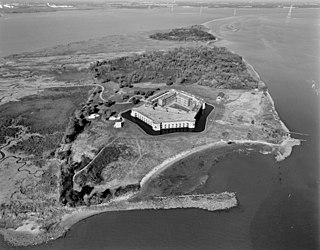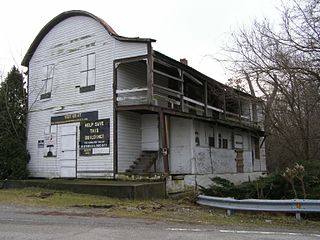Related Research Articles

Etowah Indian Mounds (9BR1) are a 54-acre (220,000 m2) archaeological site in Bartow County, Georgia, south of Cartersville. Built and occupied in three phases, from 1000–1550 CE, the prehistoric site is located on the north shore of the Etowah River.

Washington Crossing Historic Park is a 500-acre (2 km2) state park operated by the Pennsylvania Department of Conservation and Natural Resources in partnership with the Friends of Washington Crossing Park. The park is divided into two sections. One section of the park, the "lower park," is headquartered in the village of Washington Crossing located in Upper Makefield Township in Bucks County, Pennsylvania. It marks the location of George Washington's crossing of the Delaware River during the American Revolutionary War.
Indian Mound Park, also known as Shell Mound Park or Indian Shell Mound Park, is a park and bird refuge located on the northern shore of Dauphin Island, a barrier island of Mobile County, Alabama in the United States. In addition to the many birds which visit, a wide variety of botanical species contribute to the natural offerings. The site is historically significant due to the presence of prehistoric Indian shell middens, mounds composed of discarded oyster shells. The park was added to the National Register of Historic Places on August 14, 1973. It is administered by the Alabama Department of Conservation and Natural Resources.
The Garden Patch is a Middle Woodland archaeological site in Horseshoe Cove, near Horseshoe Beach, Florida, off County Road 351. For a major part of its occupation, the site was a ceremonial center associated with the Swift Creek and Weeden Island cultures. On April 25, 1991, it was added to the U.S. National Register of Historic Places.

Fort Delaware State Park is a 288-acre (117 ha) Delaware state park on Pea Patch Island in New Castle County, Delaware. A fortress was built on Pea Patch Island by the United States Army in 1815, near the conclusion of the War of 1812, to protect the harbors of Wilmington, Delaware and Philadelphia, Pennsylvania. The fort was burned and rebuilt in the years prior to the American Civil War, and soon after the start of the war the fort was converted to a Prisoner of War camp. Fort Delaware continued to protect the mouth of the Delaware River through World War I and II. Pea Patch Island and Fort Delaware was declared surplus land by the United States Department of Defense in 1945.

Lums Pond State Park is a 1,790-acre (720 ha) Delaware state park near Bear, New Castle County, Delaware in the United States. The park surrounds Lums Pond, an impoundment built by the Chesapeake and Delaware Canal on St. Georges Creek. The C&D built the pond as a source of water to fill the locks of the canal that connected the Chesapeake Bay with the Delaware River during the early 19th century. Lums Pond State Park is open for a wide variety of year-round recreation.

First State Heritage Park is Delaware's first urban "park without boundaries" linking historic and cultural sites in Dover, Kent County, Delaware, the city that has been the seat of state government since 1777. It is a partnership of state and city agencies under the leadership of Delaware State Parks. Delaware was the first state to ratify the United States Constitution. The sites of the park highlight Delaware's role as the First State. First State Heritage Park is open year-round, with special tours of the sites given the first Saturday of each month.

The Amalik Bay Archeological District is a geographic area with a significant number of archaeological sites in Alaska. It is located on the Pacific coast of Katmai National Park and Preserve, in the mainland portion of Kodiak Island Borough, Alaska.

Towosahgy State Historic Site (23MI2), also known as Beckwith's Fort Archeological Site, is a large Mississippian archaeological site with a Woodland period Baytown culture component located in Mississippi County, Missouri, United States. It is believed to have been inhabited from c. 400–1350 CE. The site is maintained by the Missouri Department of Natural Resources as a state historic site. The name Towosahgy is an Osage word which means "old town". It is not known if members of the historic Osage people, who dominated a large area of present-day Missouri at the beginning of the 19th century, ever occupied the site. The site was acquired by the Missouri state park system in 1967 and added to the National Register of Historic Places in 1969 as NRIS number 69000113.

Delaware State Park is a 1,686-acre (682 ha) public recreation area on U.S. Route 23 near the city of Delaware in Delaware County, Ohio, in the United States. It is open for year-round recreation including camping, hiking, boating, hunting, fishing, and picnicking.
The Ufferman Site is an archaeological site in the central part of the U.S. state of Ohio. Located north of the city of Delaware, it occupies approximately 2 acres (0.81 ha) of land near Delaware Lake on property near to the boundaries of Delaware State Park. It appears to have been the location of a village of the Cole culture, which inhabited the region during the later portion of the Woodland period. Ufferman lies only 0.6 kilometres (0.37 mi) south of the W.S. Cole Site, the type site for the culture, and approximately 23 kilometres (14 mi) north of the Highbank Park Works, which are believed to have been built by peoples of the Cole culture.
Salisbury Farm, also known as the Salisbury Site, is a 5-acre (2.0 ha) prehistoric and historic archaeological site located in the Bridgeport section of Logan Township in Gloucester County, New Jersey, United States. Located in the vicinity of Raccoon Creek and the Delaware River, it was the site of both Native American habitation and of early colonial settlement in the mid-17th century. The site, first investigated under the auspices of the Works Progress Administration in 1937, was added to the National Register of Historic Places on March 7, 1979. In 1939, the State Archaeologist Dorothy Cross may have found two possible earthfast buildings from the 1670s to 1680s occupation of the Salisbury site.
Barnes Woods Archeological District is a national historic district located near Seaford, Sussex County, Delaware. The district includes four contributing sites. They are two small base camps and two procurement camps, representing a segment of the settlement system of Native American groups living in the Nanticoke River drainage between about 3000 B.C. and A.D. 1700.
Wolfe's Neck Site is an archaeological site located near Lewes, Sussex County, Delaware. The early occupation of the site was apparently a small seasonal camp. The later occupation may have been a more permanent village. Excavations conducted by the Section of Archaeology, Division of Historic & Cultural Affairs, in 1975 at one of the hillside middens produced a dated sequence of ceramics from 500 B.C. to 330 A.D.
Cape Henlopen Archeological District is a national historic district located near Lewes, Sussex County, Delaware. The district includes seven contributing sites. They are a discontinuous series of discrete shell middens of varying sizes and cultural affiliation. They date from approximately 500 B.C. to 1600 A.D.

Poplar Thicket, also known as Marian R. Okie Memorial Wildlife Preserve at Poplar Thicket, is an archaeological site located in Long Neck, Delaware. Poplar Thicket is the name of a farm purchased by L.P. Faucett in 1918. It consists of forest, marshes, and wetlands spread across a quarter-mile of undisturbed Indian River Bayshore. Austin Okie, a grandson of Faucett, donated the property to The Nature Conservancy in October 2007, to serve as a bird refuge. The property was subsequently transferred to the state of Delaware, establishing it as the Marian R. Okie Memorial Wildlife Preserve at Poplar Thicket. The property is administered by the Delaware Department of Natural Resources and Environmental Control and serves as a bird sanctuary, used for conservation education and environmentally-sensitive activities such as bird-watching and walking.
The Hughes-Willis Site is a prehistoric Native American archaeological site in Kent County, Delaware. It is located in Dover, Delaware on the banks of the Little River, and was identified in 1971. The site contains evidence of occupation dating back 5,000 years, with its most significant occupational period being the Middle Woodland Period. Finds at the site include projectile points, and tools for cutting and scraping made of stone. The evidence suggests the site was occupied seasonally, probably sometime in the period between late fall and mid-winter.

The Collier Lodge site, located in Porter County, Indiana, is one of the few places the Kankakee Marsh could be easily crossed. The site has been occupied for over 11,000 years with evidence of human occupation from 1,000 B.C.E. Historic records of humans occupation in northwestern Indiana are available from the late seventeenth century. The prehistoric and historic cultural deposits are unique for northwestern Indiana. Prehistoric artifacts from the site represent most time periods over the last nine to ten thousand years and historic artifacts span the full range of historic occupations in northwestern Indiana. Prehistoric archaeological features documented at the site include two different types of roasting pits and small features whose functions are unknown. Historic features include the remains of a fireplace, post molds, and what is now thought to be a cellar marks the location of a previously undocumented structure. Concentrations of animal bones from the early nineteenth century indicate furs were processed at the site.

The Hacklander Site, also designated 20AE78, is an archaeological site located on the south shore of the Kalamazoo River east of Douglas, Michigan. It was added to the National Register of Historic Places in 1973. The site is significant because it represents much of what is understood about Woodland period life in the region.
The Roberts Island complex is an archaeological site in Citrus County, Florida, near the Gulf of Mexico, dating from the late Woodland period. It is located on an island in the Crystal River midway between the springs at the head of the river and the mouth of the river on the Gulf of Mexico. The site is a geographically separate unit of the Crystal River Archaeological State Park. The site includes three shell mounds and three middens. Two of the mounds may have had stepped sides. The Roberts Island complex was developed as the Crystal River site declined and most other ceremonial sites in the region were abandoned during the 7th or 8th century.
References
- 1 2 "National Register Information System". National Register of Historic Places . National Park Service. July 9, 2010.
- ↑ Cara Lee Blume (May 1994). "National Register of Historic Places Inventory/Nomination: Thompsons Island Site" (PDF). Delaware Department of Natural Resources and Environmental Control.

